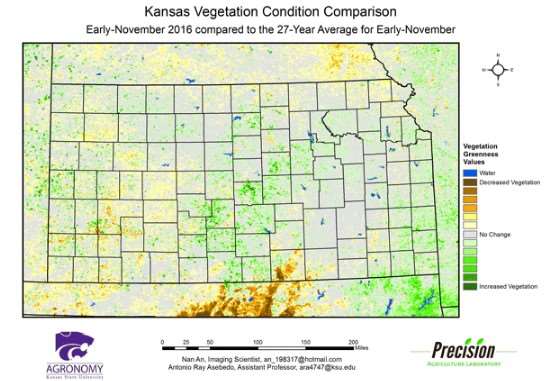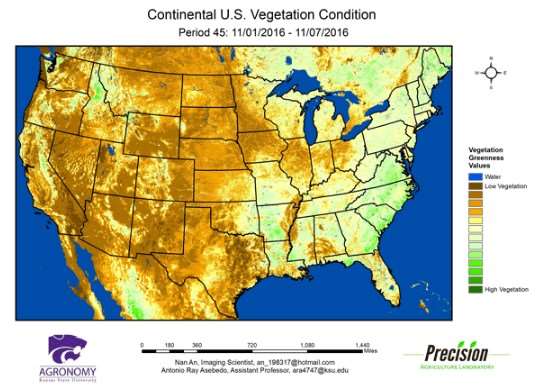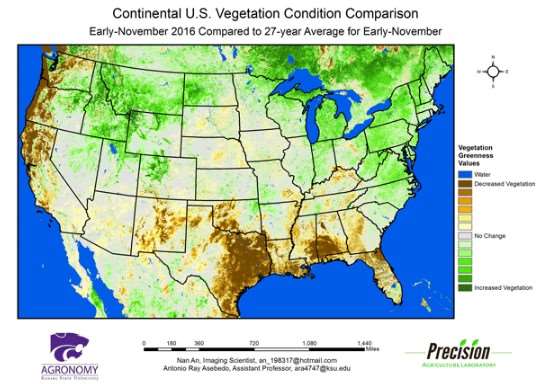By Mary Knapp
Weather Data Library
The weekly Vegetation Condition Report maps below can be a valuable tool for making crop selection and marketing decisions.
The objective of these reports is to provide users with a means of assessing the relative condition of crops and grassland. The maps can be used to assess current plant growth rates, as well as comparisons to the previous year and relative to the 27-year average. The report is used by individual farmers and ranchers, the commodities market, and political leaders for assessing factors such as production potential and drought impact across their state.
The Vegetation Condition Report (VCR) maps were originally developed by Dr. Kevin Price, K-State professor emeritus of agronomy and geography. His pioneering work in this area is gratefully acknowledged.
The maps have recently been revised, using newer technology and enhanced sources of data. Dr. Nan An, Imaging Scientist, collaborated with Dr. Antonio Ray Asebedo, assistant professor and lab director of the Precision Agriculture Lab in the Department of Agronomy at Kansas State University, on the new VCR development. Multiple improvements have been made, such as new image processing algorithms with new remotely sensed data from EROS Data Center.
These improvements increase sensitivity for capturing more variability in plant biomass and photosynthetic capacity. However, the same format as the previous versions of the VCR maps was retained, thus allowing the transition to be as seamless as possible for the end user. For this spring, it was decided not to incorporate the snow cover data, which had been used in past years. However, this feature will be added back at a later date. In addition, production of the Corn Belt maps has been stopped, as the continental U.S. maps will provide the same data for these areas. Dr. Asebedo and Dr. An will continue development and improvement of the VCRs and other advanced maps.
The maps in this issue of the newsletter show the current state of photosynthetic activity in Kansas, and the continental U.S., with comments from Mary Knapp, assistant state climatologist:
Figure 1. The Vegetation Condition Report for Kansas for November 1 – November 7, 2016 from K-State’s Precision Agriculture Laboratory shows only light photosynthetic activity. As the summer growing season comes to an end, the highest NDVI values are in the Arkansas River basin, where irrigated alfalfa is common.
Figure 2. Compared to the previous year at this time for Kansas, the current Vegetation Condition Report for November 1 – November 7, 2016 from K-State’s Precision Agriculture Laboratory shows the largest area of higher vegetative activity is in north central Kansas. Pockets of delayed development and favorable rainfall continue to be the major contributor to this higher vegetative activity. Expanding drought conditions and the slow establishment of winter wheat in the Southwest into the South Central Divisions are visible as reduced NDVI values there. A later first frost this season has extended the growing season in parts of eastern Kansas.

Figure 3. Compared to the 27-year average at this time for Kansas, this year’s Vegetation Condition Report for November 1 – November 7, 2016 from K-State’s Precision Agriculture Laboratory shows much of the state has close-to-average vegetative activity. Parts of central Kansas show above-average activity, thanks to favorable moisture and mild temperatures. The South Central Experiment Field Mesonet station near Hutchinson has not yet recorded a freeze this year. The very low NDVI values in extreme south central are due to persistent cloud cover in the region.

Figure 4. The Vegetation Condition Report for the U.S for November 1 – November 7, 2016 from K-State’s Precision Agriculture Laboratory shows the highest NDVI values are in the Southeast as mild temperatures extend the growing season. Low NDVI values are visible in the Corn Belt and along the Mississippi River Valley, where crop maturity is ahead of average. The higher NDVI values in northern Idaho and along the Cascades are of concern, as it indicates low snow cover.
Figure 5. The U.S. comparison to last year at this time for November 1 – November 7, 2016 from K-State’s Precision Agriculture Laboratory shows higher NDVI values in the Pacific Northwest. In northern Idaho, last year there was 79% snow cover at this time with an average depth of 7 inches. This year, the average snow cover is only 9 percent with an average depth of less than 2 inches.

Figure 6. The U.S. comparison to the 27-year average for the period November 1 – November 7, 2016 from K-State’s Precision Agriculture Laboratory shows below-average photosynthetic activity along the coast in the Pacific Northwest, and from east Texas along the Gulf Coast. Persistent rains and cloud cover are the major influence in the Pacific Northwest. The South continues to have persistent drought conditions, but as the typical activity is reduced anyway at this time of the year, as the map doesn’t show as much difference from the long-term average at this point in that region as there would be in other seasons.